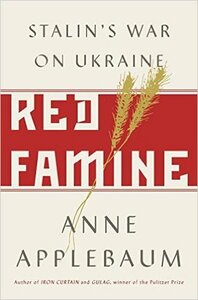Take a photo of a barcode or cover
challenging
dark
emotional
reflective
sad
tense
slow-paced
challenging
dark
informative
reflective
medium-paced
dark
informative
sad
medium-paced
dark
informative
sad
slow-paced
informative
sad
slow-paced
dark
informative
sad
medium-paced
Red Famine is the harrowing account of the 1932-33 Holodomor, a state-perpetuated season of starvation in the Ukraine. Even Russia admits that the Soviet Union experienced widespread food shortages during that year, but Applebaum (supporting the view of Ukrainian and now the majority of international historians) argues that the Ukraine was specifically targeted for its nationalistic tendencies for worse treatment during the fateful year.
The first 100 pages of Applebaum's book, which were the least interesting to me, set the groundwork for proving the Ukraine's independent traits. Following the 1917 Russian revolution, the Ukraine did function as an independent entity for a short time before the Bolsheviks reasserted authority. There was a flourishing of the arts in the Ukrainian language, and a movement to have the Russian language removed from government and civic functions, including street signs. Outspoken intellectuals asserted the existence of a separate culture from Russia. None of this was appreciated by Stalin, who worked to forcibly eliminate all allegiances other than that toward the Communist government.
I am not convinced that Stalin set out in 1932 to destroy the Ukrainian national consciousness through state-sponsored famine. But when his efforts at collectivization of agriculture failed to produce the anticipated yield, he clearly saw an opportunity to punish the Ukrainians for their "lack of collective spirit." Yes, there was hunger in many districts of the U.S.S.R., but while more loyal areas received some clemency, "trouble spots" did not. Even though harvests were smaller than expected, the peasants of the Ukraine were required to fill unrealistic grain quotas, which were used to feed the army and the proletariat urban workers. When they fell short on their quotas, volunteer squads swept through villages and used iron poles to search for hidden foodstuffs, confiscating every last kernel, even if that left people with absolutely nothing to eat. "Underperforming" areas were put on blacklists that prohibited them from trading goods for food with neighboring areas. Any resistance was punished with transportation to the Siberian gulags. When neighboring states heard about the plight of the peasants, the Soviet Union denied there was a famine, and refused the offered food aid. Modern demographers and historians estimate that between 3 and 4 million Ukrainians died between 1932 and 1933, and oral histories tell of bodies littering the roads, starving families resorting to cannibalism, and consumption of tree bark, grass, manure, and leather. Shockingly, during this time the Soviet Union continued to export grain to the West because they needed the cash to build their industrial sector.
Why would the Russian people allow this to happen? First off, the Soviet propaganda machine tightly controlled the dissemination of information, and city-dwellers were constantly told the shortfalls in grain collection were caused by selfish kulak hoarding. Ukrainian peasants were demonized as something "other" and "enemy," out to sabotage the success of the Communist state. Even within the Ukraine neighbors were encouraged to turn on neighbors, as one group and then another were scapegoated for every problem.
In the years following the famine every effort was made to cover it up. When the 1937 census returns showed a total Soviet population of 162 million, down from the previous decade, Stalin insisted it was flawed. After proscribing, transporting, or executing the academics and demographers who had worked on it, he instructed a new group of stooges to come up with a census showing 170 million, which they did. History books, especially in the Ukraine, could not discuss the starvation in 1933. Even Vladimir Putin today denies that the Ukraine was targeted in the famine.
After Ukraine declared its independence in 1991, people there at last opened their mouths and told what had happened. Diaries that had been hidden for years emerged, and there was an effort to collect the stories. This "Holodomor," or government-caused starvation, became an important part of the new Ukrainian consciousness.
Applebaum's book was eye-opening to me. And along with Timothy Snyder's Bloodlands it has convinced me that the Ukraine is a strong candidate for worst place to have lived in the 20th century!
The first 100 pages of Applebaum's book, which were the least interesting to me, set the groundwork for proving the Ukraine's independent traits. Following the 1917 Russian revolution, the Ukraine did function as an independent entity for a short time before the Bolsheviks reasserted authority. There was a flourishing of the arts in the Ukrainian language, and a movement to have the Russian language removed from government and civic functions, including street signs. Outspoken intellectuals asserted the existence of a separate culture from Russia. None of this was appreciated by Stalin, who worked to forcibly eliminate all allegiances other than that toward the Communist government.
I am not convinced that Stalin set out in 1932 to destroy the Ukrainian national consciousness through state-sponsored famine. But when his efforts at collectivization of agriculture failed to produce the anticipated yield, he clearly saw an opportunity to punish the Ukrainians for their "lack of collective spirit." Yes, there was hunger in many districts of the U.S.S.R., but while more loyal areas received some clemency, "trouble spots" did not. Even though harvests were smaller than expected, the peasants of the Ukraine were required to fill unrealistic grain quotas, which were used to feed the army and the proletariat urban workers. When they fell short on their quotas, volunteer squads swept through villages and used iron poles to search for hidden foodstuffs, confiscating every last kernel, even if that left people with absolutely nothing to eat. "Underperforming" areas were put on blacklists that prohibited them from trading goods for food with neighboring areas. Any resistance was punished with transportation to the Siberian gulags. When neighboring states heard about the plight of the peasants, the Soviet Union denied there was a famine, and refused the offered food aid. Modern demographers and historians estimate that between 3 and 4 million Ukrainians died between 1932 and 1933, and oral histories tell of bodies littering the roads, starving families resorting to cannibalism, and consumption of tree bark, grass, manure, and leather. Shockingly, during this time the Soviet Union continued to export grain to the West because they needed the cash to build their industrial sector.
Why would the Russian people allow this to happen? First off, the Soviet propaganda machine tightly controlled the dissemination of information, and city-dwellers were constantly told the shortfalls in grain collection were caused by selfish kulak hoarding. Ukrainian peasants were demonized as something "other" and "enemy," out to sabotage the success of the Communist state. Even within the Ukraine neighbors were encouraged to turn on neighbors, as one group and then another were scapegoated for every problem.
In the years following the famine every effort was made to cover it up. When the 1937 census returns showed a total Soviet population of 162 million, down from the previous decade, Stalin insisted it was flawed. After proscribing, transporting, or executing the academics and demographers who had worked on it, he instructed a new group of stooges to come up with a census showing 170 million, which they did. History books, especially in the Ukraine, could not discuss the starvation in 1933. Even Vladimir Putin today denies that the Ukraine was targeted in the famine.
After Ukraine declared its independence in 1991, people there at last opened their mouths and told what had happened. Diaries that had been hidden for years emerged, and there was an effort to collect the stories. This "Holodomor," or government-caused starvation, became an important part of the new Ukrainian consciousness.
Applebaum's book was eye-opening to me. And along with Timothy Snyder's Bloodlands it has convinced me that the Ukraine is a strong candidate for worst place to have lived in the 20th century!
informative
reflective
sad
medium-paced
challenging
informative
sad
medium-paced
challenging
dark
informative
sad
medium-paced
Trigger warnings: death, famine, starvation, cannibalism, death of a child, violence, stabbing, genocide, animal death, graphic descriptions of death, starvation and famine.
Oof. I mean, I'm glad I read this because if nothing else, it puts the current Russia situation into a new light and makes Putin's "we're all one people" bullshit even more intolerable. But oof. This is definitely not an easy read, as you would expect. But the level of dedication Stalin had to essentially wiping the Ukrainian people off the map completely was...wild. And then the gaslighting from the west (and western scholars through until the 90s!) claiming that the famine never happened and that there was plenty of food the whole time OH MY GOD I CAN'T.
Anyway. This was occasionally drier reading than I would have liked, but I'm very glad I read it.
Oof. I mean, I'm glad I read this because if nothing else, it puts the current Russia situation into a new light and makes Putin's "we're all one people" bullshit even more intolerable. But oof. This is definitely not an easy read, as you would expect. But the level of dedication Stalin had to essentially wiping the Ukrainian people off the map completely was...wild. And then the gaslighting from the west (and western scholars through until the 90s!) claiming that the famine never happened and that there was plenty of food the whole time OH MY GOD I CAN'T.
Anyway. This was occasionally drier reading than I would have liked, but I'm very glad I read it.





